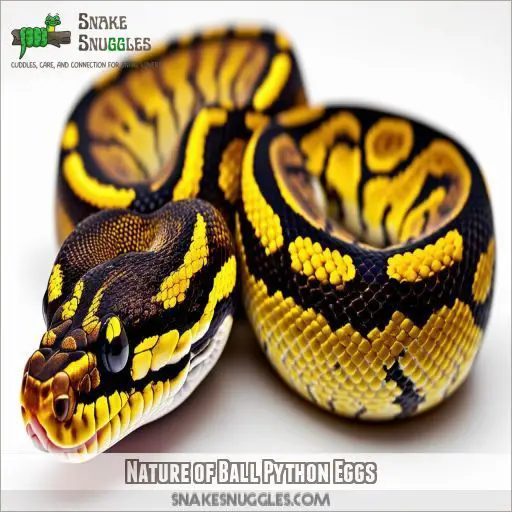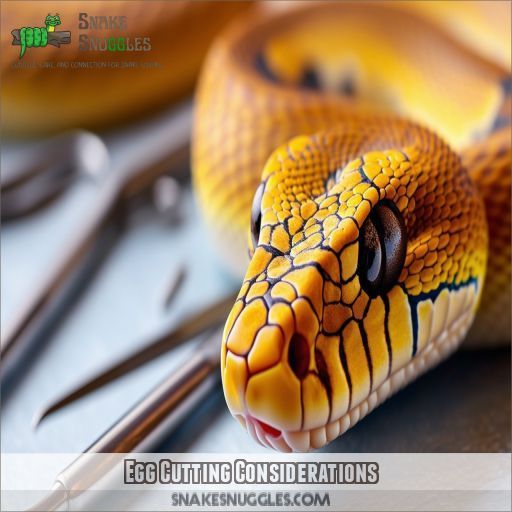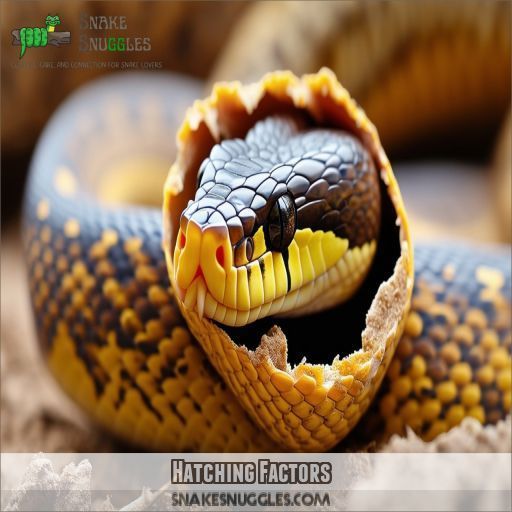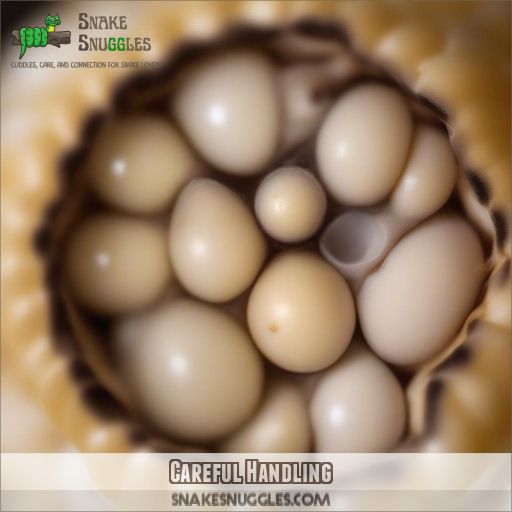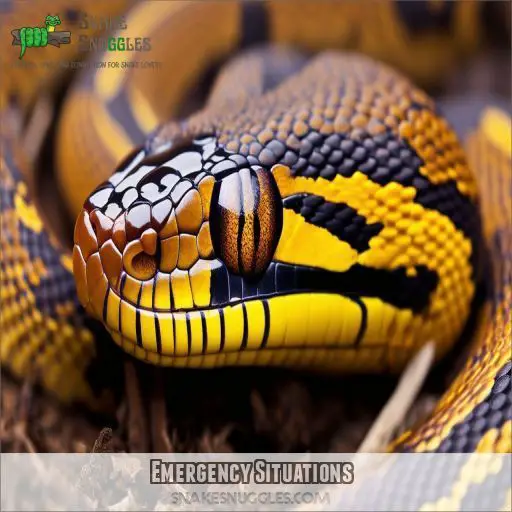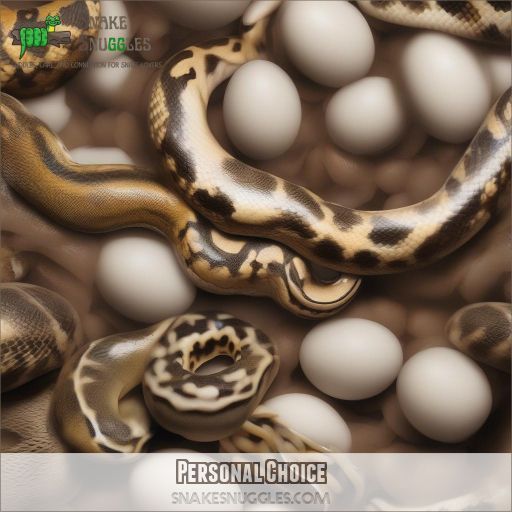This site is supported by our readers. We may earn a commission, at no cost to you, if you purchase through links.
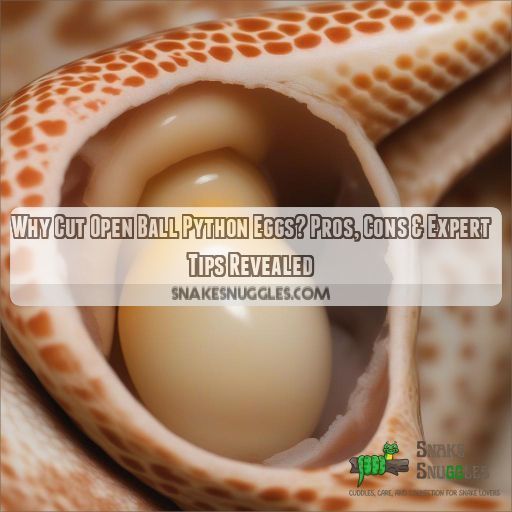 Nature holds many secrets.
Nature holds many secrets.
One intriguing mystery is the process of ball python egg incubation.
Why would anyone consider cutting open these delicate eggs?
This article will explore the pros and cons of this practice, offering expert insights and practical tips.
By the end, you’ll understand the reasons behind this technique and make informed decisions about your own ball python breeding endeavors.
Let’s embark on the realm of ball python egg cutting and uncover the fascinating details within.
Table Of Contents
- Key Takeaways
- Why Cut Open Ball Python Eggs?
- Nature of Ball Python Eggs
- Egg Cutting Considerations
- Hatching Factors
- Careful Handling
- Alternative Approaches
- Observation Benefits
- Emergency Situations
- Personal Choice
- Frequently Asked Questions (FAQs)
- Do you have to cut ball python eggs?
- Why do you remove snake eggs?
- Can I let my ball python incubate her own eggs?
- How do you unstick ball python eggs?
- What risks are there to cutting open ball python eggs?
- How can I tell if my ball python eggs are fertile?
- How do I know when a ball python egg is about to hatch?
- What do I do if the baby snake is stuck in the egg?
- Are there natural methods to help the baby snake hatch?
- Conclusion
Key Takeaways
- Cracking open ball python eggs can be like opening a treasure chest – you never know what treasures await inside. From genetic secrets to early health clues, each egg is an adventure into the unknown.
- Cutting these eggs is like playing midwife to baby snakes; you guide their entry into the world, ensuring their safe birth and improving their chances at life.
- Patience is a virtue, and it’s especially important when it comes to this process. It might be tempting to rush, but like waiting for water to boil, rushing can lead to a messy scramble. So, bide your time and let nature work its magic.
- Every egg presents a unique puzzle, and cutting it open is like uncovering a mystery. With each crack, you gain knowledge and experience, honing your skills as a wise and masterful snake breeder.
Why Cut Open Ball Python Eggs?
You might cut open ball python eggs to assess hatchling health, assist with difficult births, or gain insights into the incubation process. This practice allows breeders to detect genetic issues early, determine the sex of hatchlings, and monitor development.
However, it’s not without risks. Premature cutting can lead to injury, stress, or infection. Timing is imperative, as eggs typically hatch 55-60 days after being laid.
You’ll need to balance potential benefits against the risks and consider alternative approaches like non-intervention. Proper technique and sterile tools are essential if you decide to cut.
The choice ultimately depends on your experience and goals as a breeder. Let’s explore the nuances of this practice further.
Nature of Ball Python Eggs
Ball python eggs have evolved to protect developing embryos through a natural incubation process. The tough, leathery eggshell serves as a barrier against environmental threats while allowing for gas exchange and moisture regulation essential for the snake’s growth.
Natural Process
You’ll find ball python egg development intriguing. These reptiles have perfected their reproductive process over millions of years.
During incubation, the eggs undergo remarkable changes, with embryos growing inside their miniature worlds. Maternal incubation is common in the wild, but breeders often use egg tub setups.
As you explore ball python breeding, you’ll discover that egg viability and proper incubation techniques are essential for successful hatchling care.
Protective Eggshells
Ball python eggs boast a protective shell that’s both tough and flexible. You’ll find it’s composed of calcium carbonate, carefully deposited to shield the developing embryo.
The shell’s thickness strikes a balance, allowing for gas exchange while guarding against pathogens. Humidity levels and temperature in your incubator setup directly affect shell integrity.
As hatching approaches, the egg tooth becomes vital for breaking through this natural armor.
Egg Cutting Considerations
Cutting open ball python eggs is a common practice among breeders, but it’s not without potential risks. You’ll need to weigh the benefits of early observation against the possibility of premature intervention, considering factors like the health of the clutch and your level of experience.
Common Practice
As your eggs develop, you’ll likely encounter the common practice of egg cutting. Many breeders opt for this method to assess egg viability and assist hatching. Here’s why it’s popular:
- Early detection of genetic issues
- Opportunity for pop sexing
- Preparation for potential assist feeding
- Enhanced monitoring of hatchling development
While not essential, cutting eggs can provide valuable insights into your clutch’s health and genetic diversity. It’s a skill that, when mastered, can contribute to successful breeding outcomes.
Potential Risks
While cutting ball python eggs can offer benefits, it’s essential to understand the potential risks involved. You’re taking on a significant responsibility that could impact both egg safety and hatchling health. Let’s examine the key concerns:
| Risk Factor | Potential Consequence |
|---|---|
| Premature cutting | Underdeveloped hatchling |
| Infection | Egg or snake mortality |
| Injury to snake | Developmental issues |
| Stress | Weakened immune system |
| Ethical concerns | Interference with nature |
Careful risk assessment is essential before deciding to cut eggs. Consider creating a shopping list of sterile tools to minimize risks if you choose this route.
Hatching Factors
Ball python eggs typically hatch around 55-60 days after being laid, but the exact timing can vary. During this period, the developing snakes absorb their yolk sacs, which provide essential nutrients and energy for growth and emergence from the egg.
Time Frame
When considering the hatching timeline for ball python eggs, you’ll need to weigh several factors:
- Incubation temperature effects on development
- Expert opinion divergence on ideal cutting time
- Early intervention concerns vs. natural emergence
- Potential risks of premature cutting
- Individual egg and clutch variations
Typically, eggs are ready for cutting around day 55-60 of incubation. However, some breeders prefer to let nature take its course, avoiding potential complications from early intervention. Your decision should balance careful observation with respect for the natural process.
Yolk Absorption
You’ll find that yolk absorption time varies among ball python hatchlings. Some snakes absorb their yolk sacs quickly, while others take longer.
Early yolk absorption might prompt a snake to emerge sooner, but delayed absorption isn’t necessarily a cause for concern.
Keep an eye out for abnormal yolk absorption or complications, as these could indicate health issues.
Your patience during this critical stage is key to ensuring healthy hatchlings.
Careful Handling
When handling ball python eggs, it’s paramount to closely monitor hatchlings to verify their healthy development. Cutting eggs necessitates meticulousness to prevent injury to the emerging snake.
Monitoring Hatchlings
Monitoring the hatchlings is a critical aspect of the process. You’ll want to keep a close eye on the eggs for several days, ensuring a safe environment with adequate lighting conditions. This allows you to observe the snake’s head and monitor its health, especially during the critical period of yolk absorption.
Avoiding Injury
Regarding avoiding injury during the egg-cutting process, precision and timing are vital. The aim is to create a passage for the snake without causing harm. Here’s how to do it:
- Timing is critical: Typically, eggs are cut on day 56. By this time, blood vessels have dropped down from the egg walls, reducing the risk of bleeding.
- Use the right tool: Small suture scissors are recommended. Keep them close to the egg’s inner wall to avoid accidental cuts.
- Locate the "fold": Look for a natural "fold" or dimple in the egg, which indicates a safe starting point for cutting.
- Make a precise slit: A 2-inch slit is sufficient. This provides enough space for the snake to exit without assistance.
- Observe the head: Cutting the egg allows you to monitor the snake’s head as it hatches, ensuring a safe and controlled process.
Alternative Approaches
If you prefer a non-intervention approach, allowing nature to take its course can reduce risks associated with egg cutting. Utilizing proper incubation techniques guarantees the environment is stable, promoting successful hatching without assistance.
Non-Intervention Views
Some breeders advocate for a non-intervention approach, allowing natural hatching without any assistance. Here are a few reasons to contemplate this alternative:
- Egg Development: By letting nature take its course, you can observe the entire egg development process, from incubation to hatching, gaining valuable insights into the ball python’s life cycle.
- Egg Health: Interfering with the egg-cutting process may disrupt the natural development of the egg and potentially harm the snake inside.
- Hatching Assistance: While cutting open eggs can provide a helping hand, it’s important to remember that ball python hatchlings are capable of emerging from their eggs without assistance.
- Incubation Methods: Focusing on proper incubation methods, such as maintaining ideal temperature and humidity levels, ensures egg health and successful hatching without the need for cutting.
Incubation Techniques
Regarding incubation techniques, several key factors require consideration.
Incubation Timing:
Ball python eggs typically hatch around day 56, but it is crucial to closely observe the eggs as this timeline can vary.
Humidity and Temperature Control:
Maintaining the right humidity levels and temperature is paramount. Ideal humidity levels range from 90-95%, with a temperature of 88-90°F. These conditions give your eggs the best chance for a successful hatch.
Proper Egg Handling and Storage:
Always use sterile tools when handling eggs, ensuring their safety and preventing contamination. Store them in a secure, controlled environment to avoid damage.
Observation Benefits
Cutting open ball python eggs allows you to closely observe the hatchling’s health and development. This can be an educational experience, providing valuable insights into the natural hatching process.
Snake Health Check
Opening ball python eggs offers a unique opportunity to observe the snake’s development, allowing breeders to evaluate the health of the emerging snake and facilitate a successful transition from egg to hatchling. Here are three key benefits of this observation process:
- Health Assessment: By carefully cutting open the egg, you gain a direct line of sight to the snake’s head, enabling you to observe its vital signs and overall condition. This proactive approach ensures early identification of any potential health issues.
- Genetic Insights: A glance inside can provide clues about genetic traits. You may observe variations in color, patterning, or physical characteristics, offering insights into the hatchling’s genetic makeup and future development.
- Incubation Evaluation: Examining eggs during cutting can provide feedback on incubation methods. Assessing humidity levels, egg development, and hatchling size helps refine techniques for a conducive environment.
An Educational Experience
Cutting open ball python eggs offers an educational experience, allowing you to observe the hatching process and gain a deeper understanding of snake reproduction. You can monitor the baby snakes as they emerge, ensuring their safety and a successful incubation environment.
| Keyword | Relevance |
|---|---|
| Egg safety | Ensuring the eggs are handled carefully to avoid injury and monitoring the hatching process for any potential risks. |
| Hatching process | Observing and learning about the natural hatching timeline and the role of yolk absorption. |
| Baby monitoring | Keeping a watchful eye on the hatchlings, ensuring their well-being and providing assistance if needed. |
| Incubation environment | Maintaining suitable conditions, including temperature and humidity, for successful hatching. |
| Personal responsibility | Taking responsibility for the eggs and hatchlings, making informed decisions, and intervening only when necessary. |
Emergency Situations
In emergency situations, cutting eggs can help hatchlings stuck inside the shell. It also allows you to address potential health issues like malformed embryos or unabsorbed yolk sacs.
Stuck Eggs
Stuck eggs are an emergency situation that warrants cutting. When eggs are "stuck," the snake may be unable to exit, leading to potential health risks. Cutting the egg at this stage is a timely intervention to prevent injury and guarantee the snake’s well-being.
Health Concerns
Regarding health concerns, it’s imperative to monitor the snake’s well-being throughout this critical phase. Dissecting eggs may reveal issues with egg health, viability, or embryo development. Although rare, complications during hatching or birth defects may arise, impacting the snake’s long-term health. Careful observation is essential for identifying potential problems and seeking expert advice when necessary.
Personal Choice
Choosing to cut ball python eggs is a personal decision that involves weighing the benefits and risks. While some breeders prefer the control and insight it provides, others may opt for natural hatching to minimize potential harm.
Pros and Cons
There are several advantages and disadvantages to ponder when deciding whether or not to cut open ball python eggs.
On the one hand, cutting open eggs can provide benefits such as:
- Improved egg fertilization rates: By opening the eggs, you can guarantee that the sperm has access to the egg yolk, increasing the chances of successful fertilization.
- Enhanced egg incubation: Cutting open the eggs allows for better control of the incubation environment, including temperature and humidity, which can improve hatch rates.
- Egg viability assessment: Through a process called "egg candling," you can evaluate the development and health of the embryo inside the egg, helping you identify any potential issues early on.
- Egg cleaning and sanitation: Opening the eggs enables you to clean and sanitize them, reducing the risk of bacterial or fungal infections that could harm the developing embryo.
However, there are also potential drawbacks or disadvantages to weigh:
- Increased risk of infection: Cutting open eggs creates an entry point for bacteria or fungi, which could lead to embryo infection or death if not properly sanitized.
- Embryo damage: There’s a risk of accidentally damaging the embryo during the cutting process, which could result in developmental issues or even death.
- Time and effort: Cutting open eggs requires time, precision, and proper equipment, adding to the overall workload of breeding ball pythons.
- Unnecessary intervention: Some breeders argue that cutting open eggs is an unnecessary intervention, as ball pythons typically hatch successfully without assistance.
Individual Preferences
Ultimately, the decision to cut open ball python eggs rests with you, the breeder. While some view it as an unnecessary intervention, others advocate for its benefits in specific situations.
Your personal choice should consider the pros and cons discussed, prioritizing the safety and well-being of the snakes. Remember, successful hatching can occur with or without your assistance, and nature often finds a way.
Frequently Asked Questions (FAQs)
Do you have to cut ball python eggs?
You don’t have to cut ball python eggs, but it can be beneficial in certain situations. It’s a risky procedure that can harm the eggs and snakes if not done correctly. Some reasons to cut eggs include checking the snake’s sex, evaluating embryo health, and removing infertile eggs.
Why do you remove snake eggs?
Removing snake eggs can be beneficial in certain situations. If the female snake is unwell or underweight, taking the eggs can reduce strain on her health. In captivity, it can help maintain stable temperatures and humidity, improving the chances of successful hatching.
Can I let my ball python incubate her own eggs?
Yes, female ball pythons can incubate their own eggs, but this is harder in captivity as they won’t eat during the 55-60 day incubation period. If you want to let your female ball python incubate her own eggs, make sure she’s at least four years old and offer her a lot of food ahead of time.
How do you unstick ball python eggs?
It’s not advised to physically remove the snake from its egg. However, if the eggs are stuck together, you can use tooth floss to carefully separate them. Clean and sterilize your hands and tools first.
What risks are there to cutting open ball python eggs?
Cutting ball python eggs carries the risk of bacterial infection, drying out, and immature hatching. Cutting too early or too late can also result in the death of the snake.
How can I tell if my ball python eggs are fertile?
You can determine the fertility of ball python eggs by candling them. Shine a flashlight on the bottom of the egg in a dark room. Fertile eggs will be bright orange or red with noticeable blood vessels. Infertile eggs will be yellow or greenish.
How do I know when a ball python egg is about to hatch?
Oh, the anticipation! You’re impatiently awaiting the arrival of your baby ball pythons.
How will you know when they’re about to hatch?
Well, usually, the eggs lose their rounded shape and start to look a bit "saggy" as the shell loosens.
This process is called "dimpling," and it usually happens around day 55, indicating that your hatchlings are almost ready to emerge.
Keep an eye out for any changes in the eggs’ characteristics: shape, color, texture, weight, and smell. These clues will hint that your baby snakes are preparing to enter the world.
What do I do if the baby snake is stuck in the egg?
If a baby snake is stuck in its egg, it likely indicates a deformity in the snake’s reproductive tract.
The safest course of action is to take the snake to a veterinarian, who can surgically remove the egg.
Another option is to use a method called aspiration, which involves using a needle and syringe to extract the egg’s contents, causing it to implode.
Are there natural methods to help the baby snake hatch?
While there are no specific natural methods to help baby snakes hatch, it’s worth mentioning that some snakes hold their eggs internally until they’re ready to hatch, releasing fully developed babies. After hatching, keeping the snake warm and dry is crucial. Providing a shelter and small food items, like pinky mice, is also advisable.
Conclusion
Exposing the enigmas of ball python egg incubation, this article has examined the delicate art of dissecting these eggs.
We’ve explored the advantages and disadvantages, providing expert perspectives on the considerations, risks, and benefits.
Ultimately, the choice to dissect ball python eggs lies with the breeder. It’s a decision influenced by hatching timeframes and yolk absorption rates, as well as personal perspectives on intervention levels.
Whether you choose egg dissection or natural incubation methods, a deeper understanding of these intricate processes will strengthen your breeding journey and outcomes.

